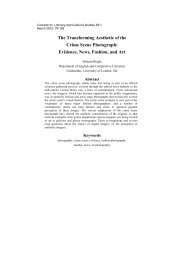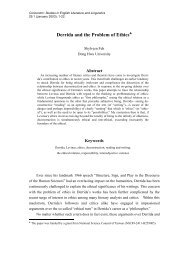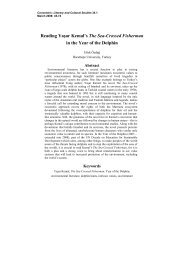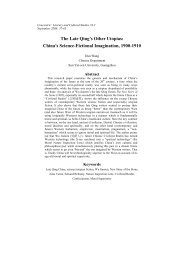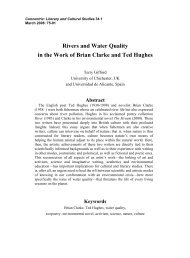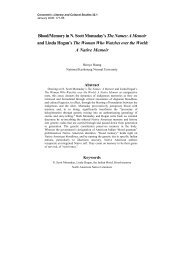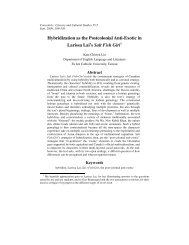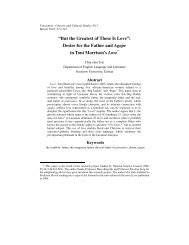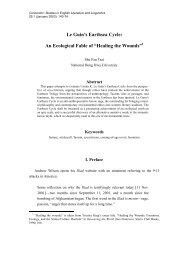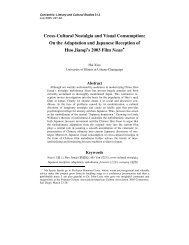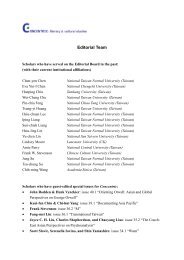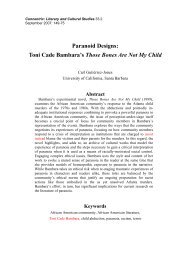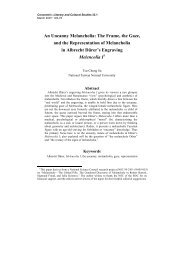A Cinematic Reading of Virginia Woolf's “Kew Gardens” - Concentric
A Cinematic Reading of Virginia Woolf's “Kew Gardens” - Concentric
A Cinematic Reading of Virginia Woolf's “Kew Gardens” - Concentric
Create successful ePaper yourself
Turn your PDF publications into a flip-book with our unique Google optimized e-Paper software.
<strong>Concentric</strong>: Literary and Cultural Studies 35.1March 2009: 181-201A <strong>Cinematic</strong> <strong>Reading</strong> <strong>of</strong><strong>Virginia</strong> Woolf’s <strong>“Kew</strong> <strong>Gardens”</strong>Chia-chen KuoDepartment <strong>of</strong> Foreign Languages and LiteraturesNational Taiwan University, TaiwanAbstractIn “The Cinema” (1926) <strong>Virginia</strong> Woolf discusses film as a new culturalproduct. However, I argue here that the author, already inspired by mainly silentfilms, began to experiment with simulating the cinematic rhythm in her writingas early as 1919 in the short story <strong>“Kew</strong> Gardens.” I show how silent films mayhave led her to try to recreate in writing the spontaneity <strong>of</strong> images and sounds,their immediate appearance on the screen as raw percepts and affects,penetrating our bodies before our minds or subjectivities can make sense <strong>of</strong>them. In addition to the Deleuzian notions <strong>of</strong> sensation (as compound <strong>of</strong> perceptand affect) and the fourth-person-singular (or nonhuman, nonsubjective)perspective or “point <strong>of</strong> articulation,” I use the notion <strong>of</strong> what I call the“voice-over voice” to interpret <strong>“Kew</strong> Gardens.” This voice, based on some <strong>of</strong>Woolf’s observations in “The Cinema,” is what appears in our minds before wecan really think, helping us to make sense <strong>of</strong> these strange and unfamiliarimages and sounds, these raw percepts-affects that change our bodily state. This“voice” is ambivalently subjective-objective, linguistic-mental-bodily, appearingand/or being heard on the movie screen and/or on our mind-screen. Theinterpretation <strong>of</strong> the story <strong>of</strong>fered here thus sees what traditionally might becalled the authorial or omniscient-narrative voice as a voice-over voice, and itelucidates the story’s fragmented multiplicities and ambivalent sense <strong>of</strong>“enclosing everything” while also “permeating into the smallest internal spaces”in the light <strong>of</strong> a Deleuzian cinematic rhythm.Keywords<strong>Virginia</strong> Woolf, “The Cinema,” <strong>“Kew</strong> Gardens,” Gilles Deleuze,fourth-person singular, affect, percept,voice-over voice, cinematic rhythm
182 <strong>Concentric</strong> 35.1 (March 2009): 181-201IntroductionThough obviously her other works have received much more attention fromcritics, “The Cinema” (1926) is Woolf’s reflection on the special role <strong>of</strong> the cinema.Most critics emphasize Woolf’s view <strong>of</strong> the cinema as a new cultural productwithout noticing that her main intention in writing this article was to reflect on theconcept <strong>of</strong> writing. Woolf discovers that the cinema possesses what the traditionalform <strong>of</strong> writing lacks, and she starts to re-envisage writing in the light <strong>of</strong> thecinema’s influence. Hence she attempts to simulate cinema’s rhythm and toincorporate it into writing in order to compose a “cinematic writing,” i.e., writingwith a cinematic rhythm. For Woolf, cinematic writing with its rhythm similar tothat <strong>of</strong> bodily sensations can approximate the “moment <strong>of</strong> affect” and <strong>of</strong> beingaffected. However, no mimetic representation can satisfy Woolf, regardless <strong>of</strong>whatever sort <strong>of</strong> cinematic rhythm she may experiment with. “The Cinema” wascomposed around the same time as Woolf’s manifestos “Mr. Bennett and Mrs.Brown” (1924) and “Modern Fiction” (1925), and thus like them should beregarded as a watershed, dividing the author’s earlier works, which still owe muchto realism, from her later works into which, perhaps most obviously in The Waves,the cinematic rhythm has been incorporated.<strong>“Kew</strong> <strong>Gardens”</strong> (1919) was published much earlier than “The Cinema” andwe can interpret its importance as an experimental story in terms <strong>of</strong> the early onset<strong>of</strong> the cinema’s influence on Woolf. It is composed with a particular cinematictrait—the cinematic rhythm. Such a rhythm can be sensed by the reader via thespontaneous appearance <strong>of</strong> sounds and images. In this very short story, there aredifferent camera shots taken from what we may call a fourth-person singular point<strong>of</strong> view in Deleuze’s sense. In addition, there is a “voice-over voice” articulating thepercepts that gather around characters when affects are acting on them in “the tenth<strong>of</strong> a second” (Benjamin, “The Work <strong>of</strong> Art” 236). Percepts and affects, for Deleuzethe compounds <strong>of</strong> sensations, can only be sensed by the body; they are not yetrecognized by the consciousness. Such a nonhuman point <strong>of</strong> articulation may beslightly different from Deleuze’s “point <strong>of</strong> hearing,” but both “hearing” and“articulation” need to be integrated with a point <strong>of</strong> view so as to abstract particularand intangible nonhuman sensations from the milieu. The integration <strong>of</strong> anonhuman point <strong>of</strong> view and point <strong>of</strong> articulation allows the reader to vibrate withthe rhythm <strong>of</strong> the narration as if she or he were seeing a film.A cinematic reading <strong>of</strong> <strong>“Kew</strong> <strong>Gardens”</strong> helps us to see that one way toapproach “the ephemeral, the fugitive, the contingent” (Baudelaire 12) affect as a
Kuo / A <strong>Cinematic</strong> <strong>Reading</strong> <strong>of</strong> <strong>Virginia</strong> Woolf’s <strong>“Kew</strong> <strong>Gardens”</strong> 183new and “modern” structure <strong>of</strong> feeling 1 may be through a cinematic writing inwhich the rhythm evoked is similar to that <strong>of</strong> bodily sensations. While many criticsnote the tremendous influence <strong>of</strong> post-impressionist painting on Woolf, taking intoaccount the relatively less conspicuous influence <strong>of</strong> the cinema on her writing maygive us a wider perspective, wider angle on Woolf’s epochal position in modernistliterature.Woolf’s <strong>Cinematic</strong> Voice-Over VoiceThe relation <strong>of</strong> Woolf to the cinema has a long history. The author <strong>of</strong>ten sawand discussed movies with her friends, and in her diary she noted her firstexperience <strong>of</strong> seeing films as early as in 1915 (Humm 187). Cinema played animportant role in her life, not only as leisure activity but also as a form <strong>of</strong>enlightenment, a stimulus to further reflection on the art <strong>of</strong> writing. As MaggieHumm and Leslie K. Hankins remind us, 1920s cinema was still very young andvigorous, still experimenting and developing. Movies started to attract film criticsas well as viewers, and Woolf participated in this flourishing visual party. 2Beginning from 1915, she first saw silent films such as “the American Fox FilmCompany’s Anna Karenina (1915) directed by J. Gordon Edwards” (Humm 188)and The Cabinet <strong>of</strong> Dr Caligari (directed by Robert Wiene) “in Germany in 1919”(Humm 186). Here I want to argue that such a silent film-viewing experienceopened up for Woolf a new way <strong>of</strong> envisaging the spontaneity <strong>of</strong> sounds andimages.In “The Cinema” Woolf claims that at the initial moment when the sound andimage appear almost spontaneously, voices appear in the viewer’s mind where theytry to express the meaning <strong>of</strong> these strange moving images (essentially being seen,unlike the images <strong>of</strong> still photography, for the first time) by speculating as to their1 “Structures <strong>of</strong> feeling” is Raymond Williams’ theoretical concept. In Cultural Theory,Andrew Edgar and Peter Sedgwick claim that structures <strong>of</strong> feeling mean “the lived experience <strong>of</strong>a particular moment in society and in history” (226), marking the exclusive experiences <strong>of</strong>perceptions at that time.2 In Hankins’s article, the Woolfs attended several film forums and at least Leonard Woolfparticipated in the activity <strong>of</strong> the Film Society Program (148-49n2) which was founded in 1925.Woolf’s closet friend Clive Bell shared his film review <strong>of</strong> Entr’acte (1924) with them (153-54)and the writing <strong>of</strong> “The Cinema” was even inspired by The Cabinet <strong>of</strong> Dr Caligari (Humm185-86). In addition, Hankins suggests that we can read the articles <strong>of</strong> a British pioneer film critic,Iris Barry with “The Cinema” juxtapositionally as if they were in a dialogue because Woolf andBarry respectively provided their comments on the flourishing phenomena <strong>of</strong> the cinema at thattime (167).
184 <strong>Concentric</strong> 35.1 (March 2009): 181-201possible meaning. Yet most <strong>of</strong> the time these mental voices were not heard because“[t]he eye licks it all up instantaneously, and the brain, agreeably titillated, settlesdown to watch things happening without bestirring itself to think” (“Cinema” 180).Nevertheless, such voices “appear” in their minds when audience members seesomething quite abstract and unfamiliar on the screen, and in that flashing momentthe eye asks the brain for help:The eye wants help. The eye says to the brain, “Something ishappening which I do not in the least understand. You are needed.”Together they look at the king, the boat, the horse, and the brain sees atonce that they have taken on a quality which does not belong to thesimple photograph <strong>of</strong> real life. They have become not more beautiful inthe sense in which pictures are beautiful, but shall we call it (ourvocabulary is miserably insufficient) more real, or real with a differentreality from that which we perceive in daily life? (“Cinema” 181)From this passage we see that in Woolf’s analysis, most <strong>of</strong> the time the eyeperceives alone, with the brain not functioning. However, at certain moments theeye is puzzled by something totally unfamiliar and the brain is called on for help,called on perhaps to “capture” the sense <strong>of</strong> certain rare percepts and affects in thefleeting moment before this frame is replaced. At this flashing moment when thebrain is also brought into play, the image and sound appear spontaneously but nowthe sound appears as voices in the viewers’ minds/brains. In other words, whenviewers’ see an unfamiliar image on the screen the first “sound” appearing in theirminds will be that expressing puzzlement in the form <strong>of</strong> a question: “What’s that onthe screen?”—or else there will be some tentative statements attempting to explainthe meaning <strong>of</strong> the image.I would like to clarify my understanding <strong>of</strong> this special form <strong>of</strong> voice. First,we should not conflate this voice with “thought” as the “thinking voice,” becausethis voice-over voice is completely spontaneous. That is, the filmgoer is not reallyaware <strong>of</strong> it as a clear-cut thought or comprehensible voice; it is what I shall call an“I-less” voice. Second, we should not confuse this voice with the auditoryhallucination <strong>of</strong> a schizophrenic: it is rather the common experience <strong>of</strong> any filmaudience member as s/he attempts to immediately comprehend the strange image onthe screen. Here I will suggest that we explain it as a function <strong>of</strong> that distraction towhich Walter Benjamin says all participants in the mass culture are subject. 3 Third,3 Benjamin argues in “The Work <strong>of</strong> Art” that distraction is a common trait <strong>of</strong> “modern” people,
Kuo / A <strong>Cinematic</strong> <strong>Reading</strong> <strong>of</strong> <strong>Virginia</strong> Woolf’s <strong>“Kew</strong> <strong>Gardens”</strong> 185we should not confuse this voice in the film viewer’s mind with the real voices intalkies, whether they appear in dialogues or monologues. Nonetheless it is true thatwhile in “The Cinema” Woolf is only influenced by silent films, she also seems tobe aware <strong>of</strong> talkies as the cinematic force <strong>of</strong> the future, with their shocking,“savage” sounds; moreover, as we have seen, she tends to perceive images andsounds together in any case. 4This particular kind <strong>of</strong> voice that appears in the filmgoer’s mind I will call the“voice-over voice.” A voice-over is normally the “<strong>of</strong>f-camera” voice we hear eithercommenting on a character’s situation or directly expressing his/her thoughts, as ifthis were his/her own inner voice. A voice-over is <strong>of</strong> course recorded independently<strong>of</strong> the actual shooting <strong>of</strong> the film. In its detachment from the real-life character, thatis, its difference from living speech (“spoken speech”), the voice-over can seemmore like writing, like the words <strong>of</strong> the narrator or author <strong>of</strong> the screenplay; in thisway it may suggest to film viewers the stream-<strong>of</strong>-consciousness technique <strong>of</strong> amodern novelist. However, when Woolf wrote <strong>“Kew</strong> <strong>Gardens”</strong> and even “TheCinema,” this particular recording technique had not yet been invented. Woolfcreated rather than simulated this particular kind <strong>of</strong> cinematic spontaneity; it wasone <strong>of</strong> her experimental techniques as a writer. Yet why did she create this? Exactlywhat did she want to capture with this spontaneity?Throughout her career, <strong>of</strong> course, Woolf pursued the goal <strong>of</strong> capturing innarrative writing the precious, transient “flash <strong>of</strong> the moment” as well as intangiblesince they are forced to receive so many stimuli all at once. Pamela Caughie says: “Distraction, inBenjamin’s analysis, is a ‘new mode <strong>of</strong> participation’ in the 1920s-1930s mass culture, one that ‘issymptomatic <strong>of</strong> pr<strong>of</strong>ound changes in apperception’ in ‘all fields <strong>of</strong> art’. . . . Here ‘distraction’refers both to the way popular culture diverts the public’s attention from high art and to the kind<strong>of</strong> inattentive listening <strong>of</strong>ten associated with mass media” (xxiii). Thus it is that Benjamin lamentsthe death <strong>of</strong> the traditional artwork with its aura. “The painting invites the spectator tocontemplation; before it the spectator can abandon himself to his associations. Before the movieframe he cannot do so. No sooner has his eye grasped a scene than it is already changed. It cannotbe arrested” (“The Work <strong>of</strong> Art” 238).4 Talkies, or films where we actually hear people speak (the old silent films could also havemusical accompaniments, the recorded sounds <strong>of</strong> trains, etc.), first appeared in 1900 in Paris andthere followed a period <strong>of</strong> experimentation and development. However, the first feature-lengthtalkie, The Jazz Singer, did not appear until 1927, a year after “The Cinema” was published. Asfor the “savage force” <strong>of</strong> the cinema <strong>of</strong> the future, in “The Cinema” Woolf says: “no greatdistance separates them [the audience] from those bright-eyed naked men who knocked two bars<strong>of</strong> iron together and heard in that clangor a foretaste <strong>of</strong> the music <strong>of</strong> Mozart” (180). At the end <strong>of</strong>the book she continues with this theme: “It is as if the savage tribe, instead <strong>of</strong> finding two bars <strong>of</strong>iron to play with, had found scattering the seashore fiddles, flutes, saxophones, trumpets, grandpianos by Erard and Bechstein, and had begun with incredible energy, but without knowing a note<strong>of</strong> music, to hammer and thump upon them all at the same time” (186).
186 <strong>Concentric</strong> 35.1 (March 2009): 181-201bodily sensations. 5 Here I will try to show how she achieves these goals in a veryparticular way by using this voice-over voice technique to “articulate” the story<strong>“Kew</strong> Gardens.” On my reading, both human voices and nonhuman sounds ornoises are captured by, or become part <strong>of</strong>, this voice-over voice in the larger“cinematic experience” <strong>of</strong> the story. The whole story is really the moment <strong>of</strong>crystallization, the spontaneous condensation <strong>of</strong> a whole world <strong>of</strong> visual andacoustic sensations which, in my view, simulates the author’s experience <strong>of</strong> seeingsilent films. For the bodily sensations, the special percepts and affects sensed by thefilm viewer’s body are beyond the bounds <strong>of</strong> language (the brain functions but notproperly) and even beyond any critical meta-language (Woolf herself could notdescribe what the percepts and affects are). In Deleuzian terms the story’svoice-over voice is, like that in a film (especially one in which characters did nototherwise speak), preconscious and even preverbal because the percept and affect inthe milieu evoke the audience’s direct bodily sensations.A Deleuzian PerspectiveLet us briefly note the Deleuzian definitions <strong>of</strong> percept, affect, and sensation.According to Deleuze and Guattari’ in What is Philosophy?, an artwork canproduce a bloc <strong>of</strong> sensations which is preserved only in and by itself and hasnothing to do with the will or intervention <strong>of</strong> the creator. As they say, “[i]t [theartwork] is independent <strong>of</strong> the creator through the self-positing <strong>of</strong> the created,which is preserved in itself. What is preserved—the thing or the work <strong>of</strong> art—is abloc <strong>of</strong> sensations, that is to say, a compound <strong>of</strong> percepts and affects” (164).Moreover, the value <strong>of</strong> the artwork, <strong>of</strong> this bloc <strong>of</strong> sensations, is not limited by theshort time (as especially with cinema, dance, music) during which the actual“material lasts,” for in momentary flash or explosion <strong>of</strong> percepts and affects therelies a certain kind <strong>of</strong> eternity:5 In “A Sketch <strong>of</strong> the Past,” Woolf says her vision <strong>of</strong> writing is to record these moments whenshe is vulnerable: “I only know that many <strong>of</strong> these exceptional moments brought with them apeculiar horror and a physical collapse; they seemed dominant; myself passive. . . . I feel that Ihave had a blow . . . it is a token <strong>of</strong> some real thing behind appearances; and I make it real byputting it into words” (72). In addition, we should not forget that in “Modern Fiction,” Woolfconfesses or explains away her meticulous stance <strong>of</strong> writing, which is different from that <strong>of</strong> theso-called materialists: “Life is not a series <strong>of</strong> gig lamps symmetrically arranged; life is a luminoushalo, a semi-transparent envelope surrounding us from the beginning <strong>of</strong> consciousness to theend. . . . Let us record the atoms as they fall upon the mind in the order in which they fall, let ustrace the pattern, however disconnected and incoherent in appearance, which each sight orincident scores upon the consciousness” (160-61).
Kuo / A <strong>Cinematic</strong> <strong>Reading</strong> <strong>of</strong> <strong>Virginia</strong> Woolf’s <strong>“Kew</strong> <strong>Gardens”</strong> 187sensation is not the same thing as the material. What is preserved byright is not the material, which constitutes only the de facto condition,but, ins<strong>of</strong>ar as this condition is satisfied . . . it is the percept or affectthat is preserved in itself. Even if the material lasts for only a fewseconds it will give sensation the power to exist and be preserved initself in the eternity that coexists with this short duration. (166)By “percept,” Deleuze and Guattari mean that which satiates the nonhumanmilieu in which affects acting on humans are “nonhuman becomings” (169).According to them, “[t]he percept is the landscape before man, in the absence <strong>of</strong>man” (ibid.). The milieu is satiated with percepts as by the production <strong>of</strong> multipleforces when they are intersecting each other at singular points. Although humansare in the milieu, they are no longer conscious and complacent subjects in thephilosophical sense because they cannot aggressively take any action, but merelyrespond passively to the forces acting on and penetrating them. Deleuze andGuattari continue here: “[c]haracters can only exist, and the author can only createthem, because they do not perceive but have passed into the landscape and arethemselves part <strong>of</strong> the compound <strong>of</strong> sensations” (ibid.).As for affect Brian Massumi, translator <strong>of</strong> A Thousand Plateaus, argues that itis “an ability to affect and be affected. It is a prepersonal intensity corresponding tothe passage from one experiential state <strong>of</strong> the body to another and implying anaugmentation or diminution in that body’s capacity to act” (xvi). Thus affect meansthe body’s ability to react to the forces acting on it. In Deleuze and Guattari’s view,affect usually bespeaks the milieu <strong>of</strong> percepts in which humans are penetrated bysome accelerating and violent forces in the moment before their consciousness or“protective shield” has begun to work. Thus they argue: “Percepts are no longerperceptions; they are independent <strong>of</strong> the state <strong>of</strong> those who experience them. Affectsare no longer feelings or affections; they go beyond the strength <strong>of</strong> those whoundergo them. Sensations, percepts, and affects are beings whose validity lies inthemselves and exceeds any lived” (Philosophy 164).Thus even though Woolf’s voice-over voice appears in the mind <strong>of</strong> eachmember <strong>of</strong> a film audience, we cannot subjectify it. As we have seen, voice-overvoice appears in the viewer’s mind when s/he sees something rare and intangible onthe screen: this voice is passively responding to the strange image seen on the“screen” (<strong>of</strong> the theater/brain) and inquiring into its meaning. Hence thephilosophical concept <strong>of</strong> the subject has not arisen yet; since “the affect is not a
188 <strong>Concentric</strong> 35.1 (March 2009): 181-201personal feeling, nor is it a characteristic; it is the effectuation <strong>of</strong> a power <strong>of</strong> thepack that throws the self into upheaval and makes it reel” (Plateaus 240), howcould one claim that these voices are subjectified? Indeed if we go one step furtherwe might say that the Deleuzian subject is a nonsubjective “superject,” reacting tothe movement <strong>of</strong> the object (The Fold 20). In Deleuze, a point <strong>of</strong> view/point <strong>of</strong>articulation is not directed from the subject or to the object; thus we cannot say thisviewer with such a voice in the mind is a conscious subject, nor can we aver that theimage on the screen is a phenomenological object, constituting certain relationswith the (non)subject. Instead we must say that the point <strong>of</strong> view, from (for) whichboth the image on the screen and the voice-over voices in the human viewers’minds are unfamiliar, is itself nonhuman, in a sense coming from nowhere andlooking at nothing.In the milieu, then, or on the plane <strong>of</strong> immanence, multiple forces areintersecting and acting on the (non)subject:every point <strong>of</strong> view is a point <strong>of</strong> view on variation [<strong>of</strong> the object]. Thepoint <strong>of</strong> view is not what varies with the subject[;] . . . it is, to thecontrary, the condition in which an eventual subject apprehends avariation (metamorphosis), or: something = x (anamorphosis). . . .[P]erspectivism amounts to a relativism, but not the relativism wetake for granted. It is not a variation <strong>of</strong> truth according to the subject,but the condition in which the truth <strong>of</strong> a variation appears to thesubject. (The Fold 20)For example, in “The Cinema” Woolf describes her experience <strong>of</strong> The Cabinet<strong>of</strong> Dr Caligari like this: she saw a shape like a tadpole on the screen and what itevoked was a direct bodily sensation <strong>of</strong> fear. That is, a voice-over voice in Woolf’smind at that moment roughly conjectured it as an image <strong>of</strong> fear and only later couldshe recognize that such an image could be understood consciously in a statement.So she retroactively records her voice-over voice at that moment: “[f]or a moment it[the image <strong>of</strong> a tadpole] seemed to embody some monstrous diseased imagination<strong>of</strong> the lunatic’s brain” (“Cinema” 183, emphasis added). Woolf’s voice-over voiceat that emerging moment tries to interpret what she sees on the screen, and thespontaneity <strong>of</strong> this sound-image simulates that <strong>of</strong> her bodily sensation <strong>of</strong> fear. She ispenetrated by percepts and affects, becoming haecceity “in the sense that [she]consist[s] entirely <strong>of</strong> relations <strong>of</strong> movement and rest between molecules or particles,capacities to affect and be affected” (Plateaus 261). Some rough, intangible,
Kuo / A <strong>Cinematic</strong> <strong>Reading</strong> <strong>of</strong> <strong>Virginia</strong> Woolf’s <strong>“Kew</strong> <strong>Gardens”</strong> 189preconscious and preverbal sensations can be sensed by her and other film audiencemembers with the spontaneity <strong>of</strong> sounds and images. As in symbolist or modern(“abstract”) poetry, there is no clear rational reason why a tadpole represents a“monstrous diseased imagination,” but the Deleuzian (and, I am suggesting,Woolfian) approach does not resort to metaphor in the traditional sense. Rather,Woolf resorts here to the preverbal and preconscious affect, and only later whencomposing “The Cinema” can she calmly, rationally analyze it: “it seemed as ifthought could be conveyed by shape more effectively than by words. The monstrousquivering tadpole seemed to be fear itself, and not the statement ‘I am afraid’” (ibid.).Just as parents’ voices constitute the primordial integration <strong>of</strong> sounds andimages when “they” are reading picture books and explaining the content to theirchildren, this time, a picture is turned into a series <strong>of</strong> moving pictures: both themovie and the parents’ voices are replaced by the silent film audience’s voice-overvoice(s). Such an initial integration <strong>of</strong> sounds and images constitutes a certainrhythm and the audience has to (collectively, communally) vibrate with it. AsBenjamin argues: “That which determines the rhythm <strong>of</strong> production on a conveyorbelt is the basis <strong>of</strong> the rhythm <strong>of</strong> reception in the film” (“Baudelaire” 175). Thisrhythm inherent in the film is almost imperceptible to the consciousness. However,right at that rare moment when the sound and image are integrated, the specificrhythm <strong>of</strong> sensations explodes, acting on the audience and forcing them to perceiveit and even to vibrate with it. And in <strong>“Kew</strong> Gardens,” Woolf amplifies such a rarecinematic rhythm and simultaneously condenses it into this short story.<strong>Reading</strong> <strong>“Kew</strong> <strong>Gardens”</strong> in a <strong>Cinematic</strong> Way<strong>“Kew</strong> <strong>Gardens”</strong> was published in 1919 and it has been considered one <strong>of</strong>Woolf’s most “experimental” stories (Briggs 76; Oakland 265; Roe 169). I will takethe “experimental” sense or feeling <strong>of</strong> the story as being closely tied to Woolf’sinterest in silent cinema, the voice-over voice and the pre-subjective cinematicrhythm as discussed above. In a letter to Vanessa Bell in January 1920, Woolfexpresses her delight at discovering a new art form after completing the story:[I am] happier today than I was yesterday, having this afternoonarrived at some idea <strong>of</strong> a new form for a new novel. Suppose onething should open out <strong>of</strong> another—as in an unwritten novel—only notfor 10 pages but 200 or so—doesn’t that give the looseness andlightness I want; doesn’t that get closer and yet keep form and speed,
190 <strong>Concentric</strong> 35.1 (March 2009): 181-201and enclose everything, everything? . . . For I figure that the approachwill be entirely different this time: no scaffolding; scarcely a brick tobe seen; all crepuscular, but the heart, the passion, humor, everythingas bright as fire in the mist. . . . Whether I’m sufficiently mistress <strong>of</strong>things—that’s the doubt; but conceive Mark on the Wall, K.G., andUnwritten Novel taking hands and dancing in unity. What the unityshall be I have yet to discover; the theme is a blank to me; but I seeimmense possibilities in the form I hit upon more or less by chancetwo weeks ago. (qtd. in Bell 72-73)This potential capacity <strong>of</strong> narrative fiction to “enclose everything” in an open-endedway—the discovery <strong>of</strong> which gave Woolf such joy—I see as tied to the newcinematic rhythm in/<strong>of</strong> her writing.Generally speaking, the critical reviews <strong>of</strong> <strong>“Kew</strong> <strong>Gardens”</strong> are diverse. First,besides observing the influence <strong>of</strong> the post-impressionist paintings on this shortstory, most critics tend to induce a central theme in <strong>“Kew</strong> Gardens.” For example,Linden Peach regards this 1919 (the final year <strong>of</strong> World War I) story as presentingthe inconspicuous but omnipresent threat <strong>of</strong> war (65). As for George M. Johnson,<strong>“Kew</strong> <strong>Gardens”</strong> is a supernatural story in which Woolf “demonstrates herambivalence toward the supernatural and reveals her trying out a new method <strong>of</strong>creating a disturbingly haunting atmosphere” (244). Another trait shared by mostcritics is that they tend to view this story as narrated by an omnipresent oranthropomorphized narrator (the snail), and from this viewpoint there is inevitably asense <strong>of</strong> totality at the end. For example, John Oakland argues for “both anacceptance <strong>of</strong> the temporariness and fragmentation <strong>of</strong> the initial impressions, butalso, in a time-lapse continuum, a realization <strong>of</strong> a continuing character identificationcomposed collectively <strong>of</strong> these moments and the reactions to them, so that a widerversion <strong>of</strong> life and selfhood is promoted” (266). Sue Roe thinks the whole story isdescribed from “a snail’s-eye view from the interior <strong>of</strong> a flower-bed” (169).Nevertheless, on my reading, then, these fragmentary impressions are theaffects <strong>of</strong> and/or acting on the characters. Fragmentary as they are, they are neitheridentifiable nor total. 6 Furthermore, the inspiration to record or capture these6 Fragments are fragments. Such a concept remind(s) me that in order to explain the concept <strong>of</strong>cultural difference, Homi Bhabha once quoted from Paul de Man to explain Benjamin’s sayingthat “Benjamin is not saying that the fragments constitute a totality, he says that fragments arefragments, and that they remain essentially fragmentary. They follow each other metonymically,and they never constitute a totality” (322n68). Even though the contexts in Bhabha and in thispaper are distinct, I want to point out that there will be no totality produced as other critics
Kuo / A <strong>Cinematic</strong> <strong>Reading</strong> <strong>of</strong> <strong>Virginia</strong> Woolf’s <strong>“Kew</strong> <strong>Gardens”</strong> 191fragmentary affects is what Woolf received from her silent-film viewingexperiences. I am taking the story as a sort <strong>of</strong> vessel containing a condensation <strong>of</strong>multiple affects, something like what one may experience (in Woolf’s view) atcertain rare moments while watching a silent film, when one is penetrated on apre-conscious level by sensations, that is, by percepts and affects. And like a filmthis story integrates images and sounds, a nonhuman viewpoint and narrative voice.The main issues I will further explore here, then, are these: In what sense is thenarrative voice in the story in effect a voice-over voice? And how do the nonhuman(fourth-person-singular) and the percepts and affects function in the story?To begin with, we need to separate this term—the fourth personsingular—into two sub-terms: “the fourth-person” and “singular.” The concept <strong>of</strong>the “fourth person” no longer indicates, as do the first, second and third persons, theidentity <strong>of</strong> the speaker in the sentence. That is, no subjective position, even nohuman position can be occupied here. From this nonhuman, nonsubjectiveperspective, anything seen on the “screen” <strong>of</strong> the story must be unfamiliar, arandom pattern <strong>of</strong> percepts and affects that accelerate and collide. Unlike thoseother personal pronouns with their concrete, precise reference, the fourth-personbespeaks nonhuman and nonsubjective blocs <strong>of</strong> sensations.As for the concepts <strong>of</strong> “singular,” “singular point” and “singularity” whichoriginally carry a topological denotation in mathematics, Deleuze uses them todescribe the point <strong>of</strong> intersection between different forces—a point at which theseforces are becoming something other than what they were and producing perceptsand affects. Just as the intersection between the “wasp and the orchid” takes placeas or at a (point <strong>of</strong>) singularity, one from which ensures an entirely different forceand one where an affective assemblage is formed, “the fourth-person singular”implies not just the nonhuman affects or forces acting on humans but also theemergence <strong>of</strong> a new force at this very moment <strong>of</strong> affecting and being affected, aforce which transforms the original relations and forms new assemblages.In <strong>“Kew</strong> Gardens,” then, Woolf presupposes a nonhuman, nonsubjectiveperspective which is not situated at that <strong>of</strong> the author, the narrator or anyanthropomorphized or human characters but as at that <strong>of</strong> a camera or the fourthpersonsingular. Jean-Jacques Lecercle also contends that “[t]he first element <strong>of</strong>structure becomes apparent when we realize that the story is composed <strong>of</strong> a number<strong>of</strong> passages that can be assimilated to camera shots in the cinema” (146). ForKai-Lin Yang a fourth-person singular viewpointclaimed because nothing is certain in that flash <strong>of</strong> moment.
192 <strong>Concentric</strong> 35.1 (March 2009): 181-201is an eye only to see singularity; however, it seems that authors haveto transform themselves into this “fourth person singular eye”sometimes. Therefore, they are no more “I,” “you” or “he.” The storythey tell is no “little story” that belongs to someone or something.They [authors] become the fourth person singular (ça? it?) . . .without self-consciousness. It is an eye only to see the pure event inlife. Here, the point <strong>of</strong> view (point de vue) or the point <strong>of</strong> hearing(point d’ouïe) concerned about multiple singularities replaces theviewpoint <strong>of</strong> the subject or the object. . . . (sic, 373) 7Thus we can read the first paragraph <strong>of</strong> <strong>“Kew</strong> <strong>Gardens”</strong> as a camera shot orcamera-eye’s view, a view or shot from a nonhuman and nonsubjective point<strong>of</strong> view:The light fell either upon the smooth, grey back <strong>of</strong> a pebble, or, theshell <strong>of</strong> a snail with its brown, circular veins, or falling into araindrop, it expanded with such intensity <strong>of</strong> red, blue and yellow thethin walls <strong>of</strong> water that one expected them to burst and disappear.Instead, the drop was left in a second silver grey once more, and thelight now settled upon the flesh <strong>of</strong> a leaf, revealing the branchingthread <strong>of</strong> fiber beneath the surface, and again it moved on and spreadits illumination in the vast green spaces beneath the dome <strong>of</strong> theheart-shaped and tongue-shaped leaves. (29)This long close-up <strong>of</strong> the flower bed, leading the reader to focus on the smallestdetails, the mutations and gradations <strong>of</strong> light and color, in effect foregrounds thestrange non-humanness <strong>of</strong> any camera shot. This point <strong>of</strong> view is neither Woolf’snor any character’s, not even the snail’s, but that <strong>of</strong> an “I-less” camera shot. As JuliaBriggs says:[t]he bed was populated by small insects and snails, moving in adifferent rhythm among the leaves and stones, a world <strong>of</strong> nature such7 Every quotation from this article comes from my own translation. The original quotation is“ 這 是 一 只 僅 能 觀 看 特 異 性 之 眼 , 然 而 每 個 作 家 在 其 生 命 的 某 一 刻 中 似 乎 都 必 然 幻 化 為 這 只『 第 四 人 稱 單 數 之 眼 』, 他 們 因 而 不 再 是 『 我 』、『 你 』 或 『 他 』, 講 述 的 也 不 再 是 特 屬 於 某人 或 某 事 的 『 小 故 事 』, 而 是 一 個 不 再 具 自 我 意 識 的 第 四 人 稱 ( 它 ?ça? it?)…… 一 只 觀 看生 命 中 純 粹 事 件 之 眼 。 在 此 , 對 複 數 特 異 性 的 觀 點 (point de vue) 或 聽 點 (point d’ouïe) 取代 主 體 觀 點 或 客 體 觀 點 ……” (373).
Kuo / A <strong>Cinematic</strong> <strong>Reading</strong> <strong>of</strong> <strong>Virginia</strong> Woolf’s <strong>“Kew</strong> <strong>Gardens”</strong> 193as is seldom perceived except by very small children, a world withoutpeople—‘not oneself but something in the universe that one’s leftwith.’ Such observed movement implies an observer, although thenarrative style resists the notion <strong>of</strong> individual consciousness, so thatthe paragraphs describing the flower-bed are, in some sense, botheyeless and “I-less.” (76)Benjamin’s optical unconscious may also imply that an unconscious“brought to light” by camera shots does not belong to any subject or object, foronly by means <strong>of</strong> these “eyeless” shots can the “I-less” unconscious emerge.Benjamin claims that “a different nature opens itself to the camera than opens tothe naked eye—if only because an unconsciously penetrated space is substitutedfor a space consciously explored by man. . . . The camera introduces us tounconscious optics as does psychoanalysis to unconscious impulses” (“The Work<strong>of</strong> Art” 236-37). Humm agrees with this idea: “The true meaning <strong>of</strong> a film doesnot derive from its narrative content but rather from the processes by which filmmore abstractly connects with a spectator’s conscious and unconscious thoughtsand memories” (189).Along with the nonhuman affects arising from the optical techniques or froma nonhuman point <strong>of</strong> view, sounds (including voices) must also be taken intoaccount. Melba Cuddy-Keane reads <strong>“Kew</strong> <strong>Gardens”</strong> as a composition <strong>of</strong> diversesounds with nonhuman percepts and affects: “there is, too, a nontraditionalperception <strong>of</strong> wholeness—comprehensive but not unified around a center—and anontraditional sense <strong>of</strong> pattern—neither humanly ordered nor anthropocentric” (85).I agree with Cuddy-Keane’s point that contemporary sound technologies motivatedWoolf to become very aware <strong>of</strong> the traits and qualities <strong>of</strong> sounds. In a sense, <strong>“Kew</strong><strong>Gardens”</strong> can be regarded as an articulation <strong>of</strong> diverse sounds, all <strong>of</strong> which aredirected towards a nonhuman “point <strong>of</strong> hearing” (Yang 373). Woolf indeed describethis “cacophony” in a passage combining organic and mechanical images, as being“like a vast nest <strong>of</strong> Chinese boxes all <strong>of</strong> wrought steel turning ceaselessly onewithin another [as] the city [murmurs] . . . ” (<strong>“Kew</strong> <strong>Gardens”</strong> 36). In addition,another description from Deleuze can also explain this phenomenon:If we suppose that the concert is divided into two sources <strong>of</strong> sound,we are positing that each hears only its own perceptions but isharmonized with those <strong>of</strong> the other even better than if it hadperceived them, because <strong>of</strong> the vertical rules <strong>of</strong> harmony that happen
194 <strong>Concentric</strong> 35.1 (March 2009): 181-201to be enveloped in their respective spontaneity. These are theharmonies that replace horizontal connections. (The Fold 80)In the beginning, we can still distinguish which sound is which. After all, wehave the human voices <strong>of</strong> the eight characters’ four dialogues: the conversation <strong>of</strong>the married couple Simon and Eleanor (29-30), that between the old man(murmuring about ghosts) and his nephew, the meaningless chitchatting <strong>of</strong> twoelderly women (32) and the two young lovers’ fragmented dialogue (33-35). Andthere are mechanical sounds: those <strong>of</strong> the aeroplane, the omnibuses and the street(35-36). However, in the end all the sounds are immersed in the larger, moreencompassing cacophony <strong>of</strong> sound or noise. Then at the end a voice-over voice says:“Voices. Yes, voices. Wordless voices, breaking the silence suddenly with suchdepth <strong>of</strong> contentment, such passion <strong>of</strong> desire, or, in the voices <strong>of</strong> children, suchfreshness <strong>of</strong> surprise; breaking the silence?” (35-36). For while the members <strong>of</strong>individual couples can hear and more or less understand each other—in fact eventhe possibility <strong>of</strong> such normal “communication” is perhaps questioned by theauthor—there is no one to hear the more generalized cacophony, the babel, or evenif there were it would after all be meaningless noise, a babel. In this sense, onceagain, the “point <strong>of</strong> hearing” is nonhuman and nonsubjective.In the traditional view <strong>of</strong> narrative fiction, the omniscient narrator is either theauthor or a figure closely related to the author; more metaphysical or allegoricalreadings may take the author and/or omniscient narrator as God, whose intention ispersonified through this author’s work as vehicle. To put it in other words, thisomniscient narrator, just like realistic writers, controls and manages everything inthe work. From the perspective <strong>of</strong> this omniscient narrator who knows all, who cansee the whole “scene,” the reader can also know everything. However, Deleuze inhis metaphysics begins from Spinoza’s idea that (contra Descartes with his puremental and pure physical substances) there is only one substance, an immanent Godwho is the world—so that everything else in the world is an attribute or aspect <strong>of</strong>God—and then takes away God so that everything is a mere contingent attribute or(virtual) aspect on the plane <strong>of</strong> immanence. Thus I would argue that, in the firstplace, the sounds (or noises) do not all proceed from a single more-or-lessidentifiable point—e.g. an omniscient narrator—and in the second place that theyare also not received by (or “heard” at) a single, concrete, stationery point. 8 Ratherwe have here an indefinite number, a multiplicity <strong>of</strong> points <strong>of</strong> articulation, and at8 Cuddy-Keane suggests that the story’s multiple sounds are directed to, or received at, “theposition <strong>of</strong> a stationary microphone” (82).
Kuo / A <strong>Cinematic</strong> <strong>Reading</strong> <strong>of</strong> <strong>Virginia</strong> Woolf’s <strong>“Kew</strong> <strong>Gardens”</strong> 195these affective points—for affect is both “to be affected” and “to affect”—there isnot even such a clear distinction between the speaker or originator <strong>of</strong> thesound/voice and the listener/receiver. This fits Deleuze’s transcendental empiricism,the Spinozan model <strong>of</strong> the world minus the underlying substance (God), and also isanalogous to the idea that a camera not only “receives” the visual image but also“makes” or “creates” it.In “Mr. Bennett and Mrs. Brown” Woolf speaks <strong>of</strong> her bewilderment in theface <strong>of</strong> an apparent multiplicity <strong>of</strong> perspectives with no one absolute orunderling one:how was I to transmit it [this confusion about perspective] to you? AllI could do was to report as accurately as I could what was said, todescribe in detail what was worn, to say, despairingly, that all sorts <strong>of</strong>scenes rushed into my mind, to proceed to tumble them out pell-mell,and to describe this vivid, this overmastering impression by likeningit to a draught or a smell <strong>of</strong> burning. (111) 9This brings us back to the central point <strong>of</strong> my interpretation, the voice-overvoice, which itself implies no clear distinction between the unfamiliar image-soundon the screen as object or subject <strong>of</strong> perception: it is an affect (both affecting andaffected), a bloc <strong>of</strong> sensations where the subject-object distinction is broken down.The “wordless voices” at the end <strong>of</strong> the story are part <strong>of</strong> the organic-and-mechanical,trans-human cacophony that may seem to enclose all yet simultaneously pervadesall, penetrates even the tiniest spaces. For again, the non-human points <strong>of</strong>articulation are simultaneously everywhere and nowhere: “Voices. Yes, voices.Wordless voices, breaking the silence suddenly with such depth <strong>of</strong> contentment,such passion <strong>of</strong> desire, or, in the voices <strong>of</strong> children, such freshness <strong>of</strong> surprise;breaking the silence?” (<strong>“Kew</strong> <strong>Gardens”</strong> 35-36).Moreover, since no single subject (character and/or reader) can occupy a point<strong>of</strong> articulation (as speaker and/or listener) permanently, in <strong>“Kew</strong> <strong>Gardens”</strong> Woolf’s(narrative simulation <strong>of</strong> a) cinematic voice-over voice will fit any audiencemember’s experience <strong>of</strong> (as it were) “seeing silent films” and trying to make sense<strong>of</strong> the strange sounds-images that appear on the screen before our minds begin to9 In “The Brown Stocking” which reviews Woolf’s To the Lighthouse, Erich Auerbach alsocontends that Woolf does not know her characters as other authors do. “[T]he author certainlydoes not speak like one who has a knowledge <strong>of</strong> [her] characters . . . and who, out <strong>of</strong> [her]knowledge, can describe their personality and momentary state <strong>of</strong> mind objectively and withcertainty” (531).
196 <strong>Concentric</strong> 35.1 (March 2009): 181-201function. In a very special sense <strong>of</strong> the term, then, we might say that the author ishere the filmmaker and thus too the omniscient narrator.Thus we could say that the four couples’ “movements” (which include theirwords, as a Deleuzian reading might also imply) in the story are shot from afourth-person singular point <strong>of</strong> view and also expressed from a nonhuman point <strong>of</strong>articulation, and it is the voice-over voice technique that integrates these. Woolfseems to have two ways <strong>of</strong> doing this. First, the camera shot is fixed on certainlandscapes or characters and a voice-over voice from nowhere describes theirstate-<strong>of</strong>-mind, what they are thinking or feeling. Thus with the fourth couple, theyoung lovers, the camera shot gives us a full view <strong>of</strong> both figures while avoice-over voice portrays the man’s intense feeling:[t]he action and the fact that his hand rested on the top <strong>of</strong> hersexpressed their feelings in a strange way, as these short insignificantwords also expressed something, words with short wings for theirheavy body <strong>of</strong> meaning, inadequate to carry them far and thusalighting awkwardly upon the very common objects that surroundthem, and were to their inexperienced touch so massive; but whoknows (so they thought as they pressed the parasol into the earth)what precipices aren’t concealed in them, or what slops <strong>of</strong> ice don’tshine in the sun on the other side? (34)The lens fixes on the man putting his hand on the woman’s and a voice-overvoice simultaneously intervenes to express the man’s feeling, perhaps his mixedfeelings or the strangeness and confusion <strong>of</strong> being in love. Here Woolf stresses thefact that normal human words (langue, voice) cannot express this, so we come backto the (omniscient) narrative or narrator’s voice as voice-over voice, by which wereaders try to make sense <strong>of</strong> it—which we can only do by entering into it, into them,into their or his feelings. In other words the intensity <strong>of</strong> their affection for eachother is beyond the limit <strong>of</strong> words so the voice-over voice gives us his/their bodilysensations by way <strong>of</strong> “explanation.” In fact, we cannot be certain <strong>of</strong> the nature <strong>of</strong>the percepts “around” them and the affects “acting on” (tactile? visual? somethingelse?) because we have in effect come too close, we have already entered into them,partaken <strong>of</strong> them. Mere words (the word “love” for example or the sentence “I loveyou”) conceal depths <strong>of</strong> danger or despair (“precipices”) and also hope (“shine inthe sun on the other side”), above all contingency, chance, uncertainty as befits aDeleuzian reading.
Kuo / A <strong>Cinematic</strong> <strong>Reading</strong> <strong>of</strong> <strong>Virginia</strong> Woolf’s <strong>“Kew</strong> <strong>Gardens”</strong> 197Second, the camera shots can also move along with the characters, a cinematictechnique called “cinestrip” (a continuous shot without montage). In this case thevoice-over voice must present certain percepts <strong>of</strong> speed and rushing in order tocatch up with the fast pace <strong>of</strong> the characters and their changing state <strong>of</strong>consciousness. For example, when later the young man in the fourth couple getstired <strong>of</strong> reflecting on the meaning <strong>of</strong> their relationship, he drags his girlfriend awaywith great determination, strength and speed like a machine, a car or train. She islooking vaguely round and letting herself be drawn on down the grasspath, trailing her parasol; turning her head this way and that wayforgetting her tea, wishing to go down there and then down there,remembering orchids and cranes among wild flowers, a Chinesepagoda and a crimson crested bird; but he bore her on. (35)Here the voice-over voice describes the not quite equivalent velocity and intensity<strong>of</strong> her reaction by describing the jerking <strong>of</strong> her neck as she turns her head, theflashing <strong>of</strong> the landscapes before her eyes which she associates with memories(having been “down there” before), but which now are closed-<strong>of</strong>f possibilities forher as his greater strength and will prevail. The syntactic structure corresponds tothis woman’s out-<strong>of</strong>-breath pace: Woolf uses a string <strong>of</strong> seven present participles toindicate how fast she is being dragged along by the man and (perhaps) how thrilledshe feels. We readers are also out <strong>of</strong> breath. The whole reading process is asimulation <strong>of</strong> the voice-over voice itself, which is our attempt to make sense <strong>of</strong>what is happening so fast that our own minds cannot quite keep up with. Theaffective-affecting, vibrating cinematic rhythm sweeps us up so that we see whatshe sees and feel what they both feel.The last paragraph <strong>of</strong> the story is an admixture <strong>of</strong> multiple sensations aseverything, including the characters (and snail) and we ourselves and also theauthor or omniscient narrator or (on my reading) voice-over voice, gets mergedtogether in the non-human perspective <strong>of</strong> the fourth-person-singular. Lecercleamong others speaks <strong>of</strong> the non-humanness <strong>of</strong> this variegated admixture <strong>of</strong> visualand acoustic sensations (144). We know neither precisely what are these shapesbeing looked at, and these voices being heard, or who is looking at them or fromwhere. Any sense <strong>of</strong> subjectivity <strong>of</strong> either perceiving subject or perceived objectdisappears (143). All is merged in one vast organic-and-mechanical assemblage:Yellow and black, pink and snow white, shapes <strong>of</strong> all these colors,
198 <strong>Concentric</strong> 35.1 (March 2009): 181-201men, women, and children were spotted for a second upon thehorizon, and then, seeing the breadth <strong>of</strong> yellow that lay upon thegrass, they wavered and sought shade beneath the trees, dissolvinglike drops <strong>of</strong> water in the yellow and green atmosphere, staining itfaintly with red and blue. It seemed as if all gross and heavy bodieshad sunk down in the heat motionless and lay huddled upon theground, but their voices went wavering from them as if they wereflames lolling from the thick waxen bodies <strong>of</strong> candles. Voices. Yes,voices. Wordless voices, breaking the silence suddenly with suchdepth <strong>of</strong> contentment, such passion <strong>of</strong> desire, or, in the voices <strong>of</strong>children, such freshness <strong>of</strong> surprise; breaking the silence? . . . [T]hecity murmured; on the top <strong>of</strong> which the voices cried aloud and thepetals <strong>of</strong> myriads <strong>of</strong> flowers flashed their colors into the air.(emphases added, <strong>“Kew</strong> <strong>Gardens”</strong> 35-36)The camera shots move sometimes faster and sometimes slower and a voice-overvoice articulates this passage, sometimes out <strong>of</strong> breath and sometimes in tranquility.We feel simultaneously dizzy and agitated. Words flash by us and lead us on.Syntactically, Woolf weaves short, rapid-fire sentences together with long, complexones in this paragraph. With the syntactic change <strong>of</strong> pace we also sense thechanges-in-velocity <strong>of</strong> the garden and the garden’s resonance with the velocity,rhythm, cacophonous music <strong>of</strong> the city. In the end, every boundary disappears andcolor, temperature, voice and velocity are distilled into crystal-like sensations. AsDeleuze and Guattari say,[T]he being <strong>of</strong> sensation is not the flesh but the compound <strong>of</strong>nonhuman forces <strong>of</strong> the cosmos, <strong>of</strong> man’s nonhuman becomings, and<strong>of</strong> the ambiguous house that exchanges and adjusts them, makes themwhirl around like winds. . . . [T]he plane <strong>of</strong> composition involvessensation in a higher deterritorialization, making it pass through a sort<strong>of</strong> deframing which opens it up and breaks it open onto an infinitecosmos. (Philosophy 183, 197)ConclusionHere I have drawn from Woolf’s own observations on her earlier experience<strong>of</strong> watching silent films, her notion <strong>of</strong> a voice-over voice, the voice that appears in
Kuo / A <strong>Cinematic</strong> <strong>Reading</strong> <strong>of</strong> <strong>Virginia</strong> Woolf’s <strong>“Kew</strong> <strong>Gardens”</strong> 199viewers’ own minds as they try to make sense <strong>of</strong> new and unfamiliar images as theyfirst flash onto the movie screen <strong>of</strong> the theater/brain. I have then used this trope orconcept <strong>of</strong> the voice-over voice to interpret the “cinematic rhythm” <strong>of</strong> the earlyexperimental story <strong>“Kew</strong> Gardens,” a reading which also brings into play theDeleuzian notions <strong>of</strong> sensation as compound <strong>of</strong> percepts and affects, thefourth-person-singular and/or nonhuman-nonsubjective perspective or “point.”Such a reading allows us to see the radically unfamiliar, experimental,paradoxical aspects <strong>of</strong> the story—its non-human or trans-human dimensions, itsmixing <strong>of</strong> the dynamic <strong>of</strong> “enclosing all” with that <strong>of</strong> “pervading into every smallspace,” its questioning (or even muting, deadening) <strong>of</strong> the powers <strong>of</strong> verballanguage, normal conversational discourse, rationality—in a way which remainsimmanent to or within the story itself, without resorting to those traditional criticaldevices or figures, <strong>of</strong> author, (omniscient) narrator, character or for that matter evensubject, object, “meaning.” (Deleuze has claimed to have no use for things like“metaphor” and “meaning”—at least in the conventional sense.)Although this point was not emphasized or pursued above, the interpretationpresented here takes a short story as being virtually the same thing as a movie—forhere again such distinctions, like those <strong>of</strong> subject/object, affecting/being affectedand author/narrator/reader, tend to break down. And one very interestingimplication <strong>of</strong> this, mentioned above but again not pursued, is that now we are ineffect looking at all the readers <strong>of</strong> a given book as being “equivalent” to all theviewers <strong>of</strong> a film, that is, to the film audience. True, I sit alone in my room readinga book, but I also sit alone there watching a movie on TV or on my computer. Still,this idea <strong>of</strong> the film audience sitting in the theater en masse and simultaneouslyexperiencing the voice-over voice, that voice which at a pre-thought level helpsthem to make sense <strong>of</strong> the strange and unfamiliar images appearing on the (on their)screen(s), is a compelling one.For one thing it brings us back to the modern (modernist) “shock” <strong>of</strong> a moremechanical world, one aspect <strong>of</strong> which was the new art <strong>of</strong> cinema, that Benjaminspeaks <strong>of</strong> in his “Baudelaire” and “Work <strong>of</strong> Art” essays. For here both the greaterindividualism <strong>of</strong> late-19 th -century big-city dwellers and the heightened “mob effect”play important roles. But for another it brings us right back into the present, to theinternet simultaneously browsed by millions, the rapid-fire “communication” <strong>of</strong>MSN network and even intra- and inter-group communication <strong>of</strong> online games.What connection this might have to a Deleuzian-cinematic reading <strong>of</strong> a short storyis not entirely clear as yet, but perhaps the strange and unfamiliar question mayseem to be appearing on the screen <strong>of</strong> an emergent future.
200 <strong>Concentric</strong> 35.1 (March 2009): 181-201Works CitedAuerbach, Erich. “The Brown Stocking.” Mimesis: The Representation <strong>of</strong>Reality in Western Literature. Trans. Willard R. Trask. Princeton: PrincetonUP, 1953. 525-53.Baudelaire, Charles. “The Painter <strong>of</strong> Modern Life.” The Painter <strong>of</strong> Modern Life andOther Essays. Trans. and Ed. Jonathan Mayne. New York: Da Cappo P, 1964. 1-40.Bell, Quentin. <strong>Virginia</strong> Woolf: A Biography. New York: Harcourt, 1972.Benjamin, Walter. “On Some Motifs in Baudelaire.” 1939. Illuminations. Ed. HannahArendt. Trans. Harry Zohn. New York: Schocken Books, 1969. 155-200.___. “The Work <strong>of</strong> Art in the Age <strong>of</strong> Mechanical Reproduction.” 1936.Illuminations. 217-51.Bhabha, Homi K. “DissemiNation: Time, Narrative, and the Margins <strong>of</strong> the ModernNation.” Nation and Narration. London: Routledge, 1990. 291-322.Briggs, Julia. “The Novels <strong>of</strong> the 1930s and the Impact <strong>of</strong> History.” Roe andSellars 72-90.Caughie, Pamela L, ed. <strong>Virginia</strong> Woolf in the Age <strong>of</strong> Mechanical Reproduction. NewYork: Garland, 2000.___. Introduction. Caughie xix-xxxvi.Cuddy-Keane, Melba. “<strong>Virginia</strong> Woolf, Sound Technologies, and the NewAurality.” Caughie 69-96.Deleuze, Gilles. The Fold: Leibniz and the Baroque. 1988. Trans. Tom Conley.Minneapolis: U <strong>of</strong> Minnesota P, 1993.Deleuze, Gilles and Félix Guattari. A Thousand Plateaus: Capitalism andSchizophrenia. Trans. Brian Massumi. Minneapolis: U <strong>of</strong> Minnesota P, 1987.___. “Percept, Affect and Concept.” What is Philosophy? Trans. Hugh Tomlinsonand Graham Burchill. London: Verso, 1994. 163-99.Edgar, Andrew and Peter Sedgwick. Cultural Theory: The Key Thinkers. London:Routledge, 2002.Hankins, Leslie Kathleen. “‘Across the Screen <strong>of</strong> My Brain’: <strong>Virginia</strong> Woolf’s ‘TheCinema’ and Film Forums <strong>of</strong> the Twenties.” The Multiple Muses <strong>of</strong> <strong>Virginia</strong>Woolf. Ed. Diane F. Gillespie. Columbia: U <strong>of</strong> Missouri P, 1993. 148-79.Humm, Maggie. “Modernist Women and Cinema.” Modernist Women and VisualCulture: <strong>Virginia</strong> Woolf, Vanessa Bell, Photography and Cinema. NewBrunswick: Rutgers UP, 2003. 157-91.Johnson, George M. “A Haunted House: Ghostly Presences in Woolf’s Essays andEarly Fiction.” <strong>Virginia</strong> Woolf and the Essay. Ed. Beth Carole Rosenberg andJeanne Dubino. New York: St. Martin’s, 1997. 235-54.
Kuo / A <strong>Cinematic</strong> <strong>Reading</strong> <strong>of</strong> <strong>Virginia</strong> Woolf’s <strong>“Kew</strong> <strong>Gardens”</strong> 201Lecercle, Jean-Jacques. “Interlude 2: Making Sense <strong>of</strong> Literature—Joyce, cummings,Woolf.” Deleuze and Language. New York: Palgrave-Macmillan, 2002. 132-53.Massumi, Brian. “Notes on the Translation and Acknowledgments.” Deleuze andGuattari A Thousand Plateaus xvi-xix.Oakland, John. “<strong>Virginia</strong> Woolf’s Kew Gardens.” English Studies 3 (1987): 264-73.Peach, Linden. “Pent-Up Voices: The Voyage Out (1915), Night and Day (1919) and‘Kew Gardens’ (1919).” <strong>Virginia</strong> Woolf. New York: St. Martin’s, 2000. 40-66.Roe, Sue. “The Impact <strong>of</strong> Post-Impressionism.” Roe and Sellars 164-90.Roe, Sue and Susan Sellars, eds. The Cambridge Companion to <strong>Virginia</strong> Woolf.Cambridge: Cambridge UP, 2000.Woolf, <strong>Virginia</strong>. “A Sketch <strong>of</strong> the Past.” Moments <strong>of</strong> Being: A Collection <strong>of</strong>Autobiographical Writing. 1976. Ed. Jeanne Schulkind. San Diego: Harcourt,1985. 64-159.___. <strong>“Kew</strong> Gardens.” 1919. A Haunted House and Other Short Stories. San Diego:A Harvest/HBJ Book, 1972. 28-36.___. “Modern Fiction.” 1925. The Essays <strong>of</strong> <strong>Virginia</strong> Woolf. Vol. IV: 1925-1928. Ed.Andrew McNeillie. London: The Hogarth, 1994. 157-65.___. “Mr. Bennett and Mrs. Brown.” 1924. The Captain’s Death Bed. New York:Harcourt, Brace and World, 1950. 94-119.___. “The Cinema.” 1926. The Captain’s Death Bed and Other Essays. New York:Harcourt, 1950. 180-86.Yang, Kailin ( 楊 凱 麟 ). “Luo Yi-Jyun’s Fourth-Person-Singular Writing (2/2):Temporal Cartography” ( 駱 以 軍 的 第 四 人 稱 單 數 書 寫 (2/2): 時 間 製 圖學 ).Tsing Hua Journal <strong>of</strong> Chinese Studies 35.2 (2005): 369-403.About the AuthorChia-chen Kuo ( 郭 家 珍 ) graduated from National Chiao-Tung University, Taiwan. Shereceived her MA degree in English and American Literatures at National Central University,Taiwan. The title <strong>of</strong> her thesis is “Shadow, Penumbra and Female Empowerment in Mrs.Dalloway.” Her past research emphasized the gender issue and post-colonialism. She iscurrently a PhD student at National Taiwan University, specializing in modernist literatureand cultural theory.Email: piopcina@yahoo.com.tw[Received 13 February 2008; accepted 15 January 2009; revised 15 February 2009]
202 <strong>Concentric</strong> 35.1 (March 2009): 181-201



